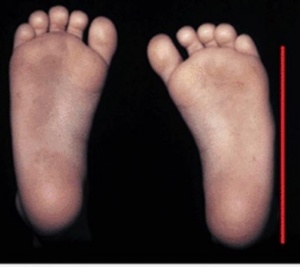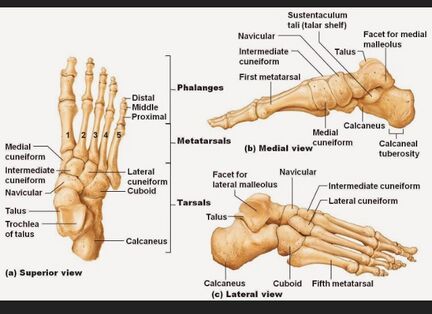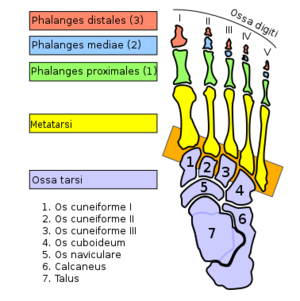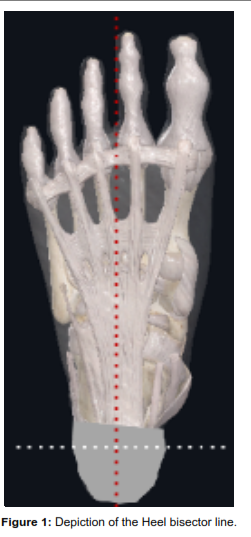Metatarsus Adductus: Difference between revisions
No edit summary |
No edit summary |
||
| Line 19: | Line 19: | ||
== Clinically Relevant Anatomy == | == Clinically Relevant Anatomy == | ||
See: [[Comprehensive Anatomy of the Foot and Ankle|Basic Structure of the Foot and Ankle]] | |||
Lisfranc joint | '''Forefoot is comprised of:''' Tarsometatarsal Joints, Intermaetatarsal Joint, Metatarsophalangeal Joints and Interphalangeal Joints.<ref name=":0">Magee, D. J. (2008). Orthopedic physical assessment. St. Louis, Mo: Saunders Elsevier.</ref> | ||
'''Hindfoot is comprised of :''' Tibiofibular joint , Talocular joint and the Subtalar (Talocalcanean) joint.<ref name=":0" /> | |||
'''Midfoot (Midtarsal Joints) is comprised of:''' Talocalcaneonavicular Joint, Cuneonavicular Joint, Cuboideonavicular Joint, Intercuneuform Joints, Cuneocuboid joint and the Calcaneocuboid Joint.<ref name=":0" /> | |||
[[File:Bones_of_the_Foot.jpg|alt=|right|frameless|432x432px]] | |||
'''[[Metatarsals]]''' | |||
* These are the 5 long bones found in the foot.<ref name=":8">Moore KL, Dalley AF. Clinically oriented anatomy. Wolters kluwer india Pvt Ltd; 2018 Jul 12.</ref> | |||
* The metatarsals and tarsal bones help form the main arches of the foot - essential for weight-bearing and ambulation.<ref name=":8" /> | |||
'''Lisfranc joint'''<ref>Chaney DM. [[The Lisfranc joint]]. Clinics in Podiatric Medicine and Surgery. 2010 Oct 1;27(4):547-60.</ref> | |||
The Lisfranc joints are tarsometatarsal articulations. Most of the joint is the articulation between the: | |||
[[File:Lisfranc articulation.png|left|thumb|The orange bar in this image highlights the articular region of the tarsometatarsal joints]] | |||
# Medical surface of the 2nd metatarsal base | |||
# Lateral surface of the medial cuniform. | |||
* The Lisfranc ligament spans this joint and is crucial for stability of the entire tarsometatarsal joint. | |||
* Musculotendinous structures around the joint provide indirect stability to the joint. | |||
It is caused by in-utero position and constriction of the fetus.<ref name=":4">Merens TA. The toddler gait—normal or not. Pediatric Annals. 2015 May 1;44(5):187-90.</ref>It is also called as pigeon toes. | It is caused by in-utero position and constriction of the fetus.<ref name=":4">Merens TA. The toddler gait—normal or not. Pediatric Annals. 2015 May 1;44(5):187-90.</ref>It is also called as pigeon toes. | ||
Revision as of 21:03, 17 December 2022
This article or area is currently under construction and may only be partially complete. Please come back soon to see the finished work! (17/12/2022)
Introduction[edit | edit source]
Metatarsus adductus (MA), also known as metatarsus varus, is a deformity occurring only in the transverse plane of the foot.[1] It is an adduction deformity or medial deviation of the forefoot at the tarsometatarsal joints (Lisfranc joint) with respect to the hindfoot.[2] [3]. This occurs in association with soft tissue contractures. A convex lateral border of the foot and prominent styloid process. is observed[4]The foot therefore is observed as 'C' shape.
MA may also be known as metatarsus varus, metatarsus adductovarus, pes adductus, metatarsus supinatus, forefoot adductus and hooked forefoot.[5]
Differential diagnosis[edit | edit source]
Clinically Relevant Anatomy[edit | edit source]
See: Basic Structure of the Foot and Ankle
Forefoot is comprised of: Tarsometatarsal Joints, Intermaetatarsal Joint, Metatarsophalangeal Joints and Interphalangeal Joints.[6]
Hindfoot is comprised of : Tibiofibular joint , Talocular joint and the Subtalar (Talocalcanean) joint.[6]
Midfoot (Midtarsal Joints) is comprised of: Talocalcaneonavicular Joint, Cuneonavicular Joint, Cuboideonavicular Joint, Intercuneuform Joints, Cuneocuboid joint and the Calcaneocuboid Joint.[6]
- These are the 5 long bones found in the foot.[7]
- The metatarsals and tarsal bones help form the main arches of the foot - essential for weight-bearing and ambulation.[7]
Lisfranc joint[8]
The Lisfranc joints are tarsometatarsal articulations. Most of the joint is the articulation between the:
- Medical surface of the 2nd metatarsal base
- Lateral surface of the medial cuniform.
- The Lisfranc ligament spans this joint and is crucial for stability of the entire tarsometatarsal joint.
- Musculotendinous structures around the joint provide indirect stability to the joint.
It is caused by in-utero position and constriction of the fetus.[9]It is also called as pigeon toes.
The child having this deformity walks with an in-toe gait during early infancy.[9]
In many cases it is self-limiting too.[10]
Types[edit | edit source]
Metatarsus Adductus can be divided into either flexible or rigid:
Flexible: Presents with adduction of the 5 metatarsal bones at the tarsometatarsal joint.
Rigid: Presents with medial subluxation of the tarsometatarsal joints. There is valgus of the hindfoot and the navicular is later to the head of the talus.
Classification[edit | edit source]
The most common classification of MA is by the Bleck manual assessment [11]or 'heel bisector method'. This system comments on both the severity (mild, moderate or severe) and the reducibility/ flexibility (fully flexible, partially flexible or severe).[1]
Heel bisector line[edit | edit source]
This was discovered by Bleck. It was used to assess the severity of Metatarsus adductus and even used as a treatment outcome measure of stretching applied for this condition.
This is a simple measure that assesses the flexibility and severity of the metatarsus adductus. It is a manual assessment and no types of equipment are needed.[10]
Advantages of Bleck[edit | edit source]
Disadvantages Bleck[edit | edit source]
- Drawbacks to this classification is that it has no prognostic value.[1]
- There has been little research into the measurement properties of the tool.[4]
Other assessment methods[edit | edit source]
To grade severity:[4]
- Multiple radigraphic angles - There is a disadvantage in this technique as it does not comment on the ridged vs flexible aspect of the MA. Furthermore, in the paediatric population, the lack of tarsal bone ossification makes angle measurements difficult. The studies with the highest rate of reliability are usually performed after the age of 5.
- Photocopies of the child's foot
- V- finger test
- Ultrasound - This assessment allows for the imaging of cartilaginous structures. allows for differentiation between MA and skewfoot. In MA the medial cuniform is displaced laterally over the navicular.
Grade 1[edit | edit source]
Adduction of the forefoot without inversion and passive abduction is possible either manually or by the means of electrical stimulation.
Grade 2[edit | edit source]
The foot is shortened a bit. The forefoot is in adduction and inversion. The external border of the foot is convex whereas the internal border is concave. The base of the fifth metatarsal is prominent. This can be partially corrected.
Grade 3[edit | edit source]
This consist of a structural deformity where the length of the foot is shortened. Surgical correction is the only option in this grade.
Transverse sulci is in medial region of the foot, increased internal longitudinal arc. Passive correction is not possible.
Epidemiology[edit | edit source]
MA is cited as being the most common congenital foot deformity in newborns.[12] In a 2019 article by Rampal and Giuliano, it was stated as occurring in 0.2% of births.[1]In an article published in June 2022, MA prevalence was cited as an estimated 1/1000 births.[13]
Etiology[edit | edit source]
Metatarsus adductus is a foot deformity. Deformities are congenital pathologies that often occur during the fetal period to certain structures - in this case the foot - which has developed normally. This is in contrast to malformations, which occur during the embryonic period of development, causing anatomical defects.[1]
The cause of metatarsus adductus remains unknown. It is however, thought to be related to intrauterine compression, osseous abnormality and abnormal muscle attachments - including abnormal tendon insertion of tibialis anterior, tibialis posterior and abductor hallucis muscles. Family history may also be a causative factor .[5][4]
Clinical Presentation[edit | edit source]
MA presents at birth with adduction of the metatarsals at the Lisfranc joint. The forefoot is medially deviated to the hindfoot, and thus appears as a concavity along the medial border of the foot and convexity on the lateral aspect. There is no deformity along the frontal or sagittal planes. The base of the 5th metatarsal appears prominent with no dorsolateral bump present (more indicative of skewfoot).[1]
Radiologically the first metatarsal is medially deviated with an increased angle between the 1st and 2nd metatarsal.[1]
Diagnostic Procedures[edit | edit source]
Transmalleolar Axis Bisector[edit | edit source]
This is a geometric tool used to do the clinical assessment of Metatarsus Adductus.
Management / Interventions[edit | edit source]
Self correction of MA only occurs in moderate forms. If it does not resolve in the first weeks of life, non-operative treatments are initiated. These include:
Casting
Curved hypercorrection pads
Orthotics
Strapping
With these treatments, the goal is to correct the deformity before ambulation is started.
Operative treatment is undertaken if conservative treatment fails or the child is > 4 years old at time of diagnosis.
Cahuzac procedure: Opening the cuneometatarsal joint capsule at the 1st ray and abduction oseotomy of metatarsals 2, 3 and 4.
Preferred technique: Opening-wedge osteotomy at the base of metatarsals 2 - 5.
A note on procedures noted in Rampal & Giuliano (2019) pg. s116 para 8 . : "Osteotomies performed on the 1st cuniform can impact the hind-foot (elevation of foot’s medial arch, without lengthening of medial column due to excessively tight plantar fascia" [1]
This condition mostly doesn't require any form of treatment and resolves on its own. The conditions like cerebral palsy, spina bifida, Slipped capital femoral epiphysis, congenital displacement of the hip, and metabolic disorders like rickets, osteogenesis imperfecta needs to be ruled out.[14]
Specific treatment for metatarsus adductus is often determined by the following factors:
- Child's Age
- Medical History
- The extent of the condition
- Tolerance for the specific procedure
- Expectations for the condition
Interventions include:[edit | edit source]
- Passive Stretching
- Passive Manipulation exercises
- Stretching
- Serial Casting
- Footwear
- Surgery to release the joints
References[edit | edit source]
- ↑ 1.0 1.1 1.2 1.3 1.4 1.5 1.6 1.7 1.8 Rampal V, Giuliano F. Forefoot malformations, deformities and other congenital defects in children. Orthopaedics & Traumatology: Surgery & Research. 2020 Feb 1;106(1):S115-23.
- ↑ Dietz FR. Intoeing--fact, fiction and opinion. American Family Physician. 1994 Nov 1;50(6):1249-59.
- ↑ 3.0 3.1 Alonge VO. Proposing Transmalleolar Axis Bisector (TMAB) as a Geometrically Accurate Alternative to the Heel Bisector Line for the Clinical Assessment of Metatarsus Adductus. Int J Foot Ankle. 2020;4:041.
- ↑ 4.0 4.1 4.2 4.3 4.4 4.5 4.6 Marshall N, Ward E, Williams CM. The identification and appraisal of assessment tools used to evaluate metatarsus adductus: a systematic review of their measurement properties. Journal of foot and ankle research. 2018 Dec;11(1):1-0.
- ↑ 5.0 5.1 Hassan N, Roger J (2015) Management of Metatarsus Aductus, Bean-Shaped foot, residual clubfoot adduction and Z-shaped foot in children, with conservative treatment and and double column osteotomy of the first cuneiform and cuboid. Ann Orthop Rheumatol3(3):1050.
- ↑ 6.0 6.1 6.2 Magee, D. J. (2008). Orthopedic physical assessment. St. Louis, Mo: Saunders Elsevier.
- ↑ 7.0 7.1 Moore KL, Dalley AF. Clinically oriented anatomy. Wolters kluwer india Pvt Ltd; 2018 Jul 12.
- ↑ Chaney DM. The Lisfranc joint. Clinics in Podiatric Medicine and Surgery. 2010 Oct 1;27(4):547-60.
- ↑ 9.0 9.1 Merens TA. The toddler gait—normal or not. Pediatric Annals. 2015 May 1;44(5):187-90.
- ↑ 10.0 10.1 Marshall N, Ward E, Williams CM. The identification and appraisal of assessment tools used to evaluate metatarsus adductus: a systematic review of their measurement properties. Journal of foot and ankle research. 2018 Dec;11(1):1-0.
- ↑ Bleck EE. Metatarsus adductus: classification and relationship to outcomes of treatment. Journal of pediatric orthopedics. 1983 Feb 1;3(1):2-9.
- ↑ Williams CM, James AM, Tran T. Metatarsus adductus: Development of a non‐surgical treatment pathway. Journal of Paediatrics and Child Health. 2013 Sep;49(9):E428-33.
- ↑ Rocca G, De Venuto A, Colasanto G, Zielli SO, Mazzotti A, Faldini C. Congenital metatarsus varus: early diagnosis and conservative treatment in 112 patients. Musculoskeletal surgery. 2022 Jun 18:1-6.
- ↑ Berry KM. Evidence-Based Management of In-Toeing in Children. Clinical Pediatrics. 2018 Oct;57(11):1261-5.










